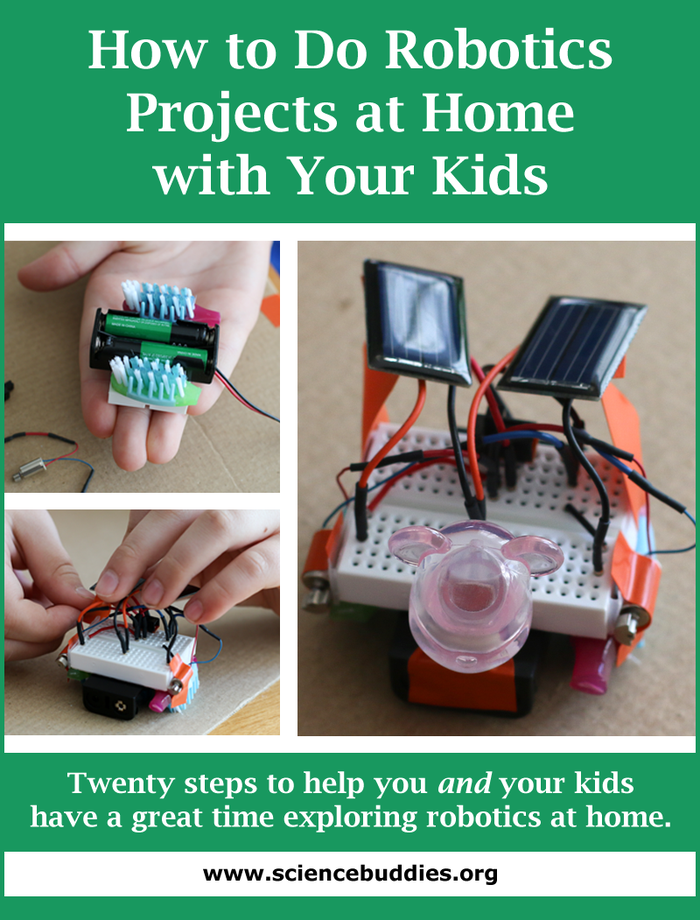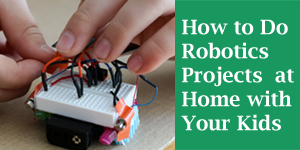20 Tips for Doing Robotics with Kids
Introductory robotics projects made with toothbrush heads and other household materials can be a great way to let kids explore hands-on electronics and robotics. We have tips and reminders to help your family robotics project be fun for everyone and a science education success.

How to Do Robotics Projects at Home with Your Kids: Twenty steps to help you and your kids have a great time exploring robotics at home. www.sciencebuddies.org
- Pick a great project. Find a project that fits the age and experience of the student.
- Plan ahead. Gather required specialty items/electronics supplies in advance.
- Have googly eyes on hand. (An assortment of googly eyes, pipe cleaners, colored electrical tape, buttons, and other craft supplies may be very useful.)
- Keep the goal in mind. (If the project is for fun rather than for an assignment or science fair, the building itself may be the focus, not the testing of different versions or variables.)
- Verbally identify all the materials before you begin. (Run through the materials list out loud, pointing out the correct part(s) in the workspace so the student visually identifies each one. This also helps you make sure you know what each item is—and ensures you are not missing a critical piece!)
- Follow the step-by-step directions. Pull them up on a device—or print them out.
- Let your student do the build. (You may want to read steps out loud for younger students, but let the student do each step.
- Be patient. Wait until a step is completely finished before moving on. (You may have to repeat directions several times during a single step.)
- Don't worry if things are not perfectly straight. (Perfectly straight isn't the sign of a successful robotics project!)
- Don't worry if they count and recount breadboard holes again and again (or say their ABCs) with each step. (The extra counting shows they are being careful.)
- Don't take over if they are struggling. Resist the urge to say, "Here, I'll do it."
- Be prepared for singing and/or chanting throughout the project.
- Encourage them to be problem solvers and to think creatively. "The looped tape you used isn't holding the motor in place? What else could you try?" "That jumper wire is a bit longer than the gap? How can you make it seem shorter?"
- Have them stop and check their build at various points to help ensure they have configured things properly before moving on to next steps.
- Ask questions that help them talk out loud about what they are doing and why.
- Remain calm if it doesn't work.
- Be prepared to go back through the steps and troubleshoot if it does not work at first. (Help your student carefully compare each element in the circuit to any photos or diagrams in the project.)
- Let them personalize their creation. Even when you don't expect it, the process of adding eyes, a head, or even a toy driver to their robot helps them take ownership of the project.
- Celebrate the successful completion of the robotics project! Let your student know what a great job she did building her bot!
- Ask the all-important last question: "What kind of robot should we build next time?"
Where to Start
The 25+ Robotics Projects, Lessons, and Activities resource helps educators find lessons and activities for use with K-12 students.
See also the following activities and projects to get inspired and pick a robotics exploration to do with kids:
- Build Fun Robots with Students
- Junkbots: Robots from Recycled Materials
- Build a Bristlebot, a Tiny Toothbrush Robot
- Build a Brushbot
- Art Bot: Build a Wobbly Robot That Creates Art
- Racing Bristlebots: On Your Mark. Get Set. Go!
- Build a Light-Tracking Bristlebot
- Build a Solar-Powered Bristlebot
- Design Your Own Vibrobots
- Flippy, the Dancing Robot
The following posts offer examples of hands-on robotics in action to help as you plan for hands-on robotics with your children:
- Not a Normal Week: Doing Fun Science at Home during School Closures (Activity #9)
- Flippy the Robot Dances (and Falls Apart)
- Building a Solar-powered Bristlebot
- Four Fun Builds in One BlueBot Robotics Kit!
- Building a Halloween Brushbot: Family Robotics
- Family Robotics: Toothbrush Bots that Follow the Light
- Building Bristlebots: Basic Toothbrush Robotics
- Create a Carnival of Robot Critters this Summer
- Bot Building for Kids and Their Parents: Celebrating Student Robotics
- Dive Into Robotics with Robotics: Discover the Science and Technology of the Future
- Students 3D Design and Print Their Own Robots with Autodesk Tinkercad
- Bristlebots at the Museum
- Build a BlueBot Over Break
- Explore the World of Robotics with This Suite of Projects
These Science Buddies Kits contain the specialty parts needed for various kinds of introductory robots:
Categories:
You Might Also Enjoy These Related Posts:
- 15 STEM Gifts & Science Kits You'll Feel Good About Giving
- 13 Boat Science and Submarine Science Projects and Experiments
- July 4th STEM! Summer Science Picks for Independence Day!
- 12 Science Kits for Summer Science Experiments and Discovery
- 15 Science Projects to Make and Give for Father's Day
- Ready, Set, Go! (Awesome Summer Science Experiments)
- Awesome Summer Science Experiments
- 10 STEM Activities with Cardboard Tubes










